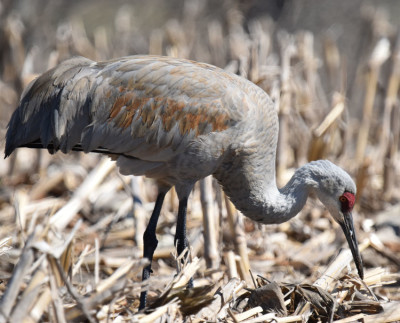Standing around wind-swept road sides in -2C weather can lead to too much time to think. As I took an entire memory card of photos of one calm, quiet placid Sandhill Crane I wondered why I was pressing the shutter release button so often and when I would know it was time to stop.
Why Do I Take So Many Photos on a Nature Ramble?
The two most common reasons that I take photos of birds, butterflies and flowers are:
- to correctly identify the creature or plant
- to remember when and where I saw it
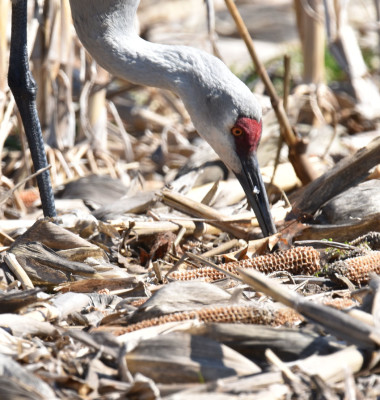
There were more corn cobs still in the field than I realized from a distance. I wonder how many kernels rodents, birds and deer found this past winter?
For example, if I am walking around the Rattray Marsh, I take a photo each time I see a Robin or a Downy. I know what they are but I want to remember that I saw them and how many I saw. I use the photos to prompt my memory when I write up my notes later and when I report my sightings to online databases like eBird and Turtle Tally.
When Do I Stop Taking Photos of a Subject?
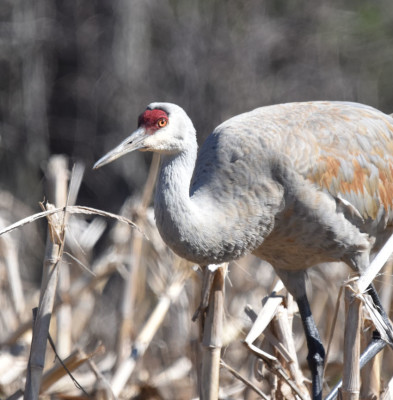
When a car or plane passed, the Crane would raise its head for a second.
I stop immediately if I think I am disturbing the subject. The creature and its life are much more important than my photograph of it.
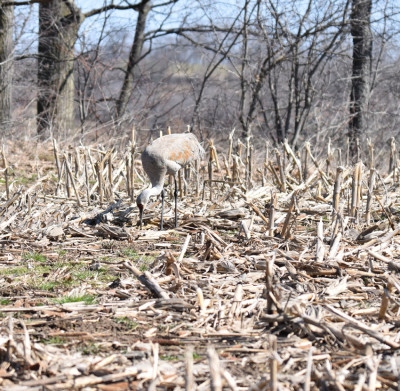
For such a large bird, they blend in reasonably well with cornstalks and cattails.
For example, a Phoebe hunting for insects needs that food to stay alive. But it also needs every insect it devours to create the energy surplus necessary to fertilize or lay an egg. Who knows how delicate that energy balance is? Interrupting the bird could possibly result in one fewer new Phoebes being hatched this year—and that could eventually lead to a decline in the species as a whole. No photo is worth that risk.
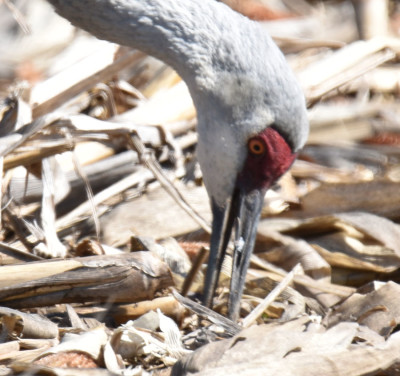
The Sandhill often stuck its open bill deep into the wet soft soil.
For common species, I usually just take a quick “count” shot and move on. I may take more time if I’m trying to document something about its behaviour, such as courting, nest building or feeding. But if it seems bothered by me, off I go. And even if it seems unbothered, I limit my intrusion to a few minutes or less.
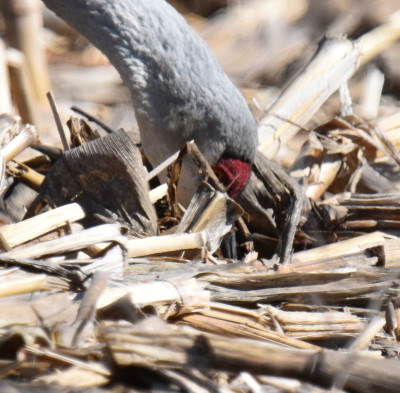
It would plunge the bill quite deep.
For uncommon species, I move on immediately if I can see a reaction from the creature to my presence, or fairly quickly if it doesn’t seem bothered by me. If it’s obvious that it could care less that I am there, such as the reaction (or lack thereof) of this Sandhill Crane to our presence, I may stay longer.
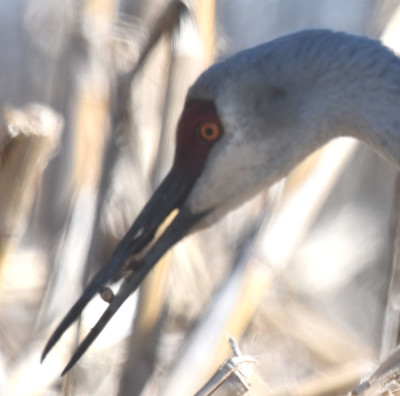
I’m not sure, but it looks like it has caught a snail.
The Sandhill did react to various things such as passing cars, passing airplanes, and other birds flying overhead.
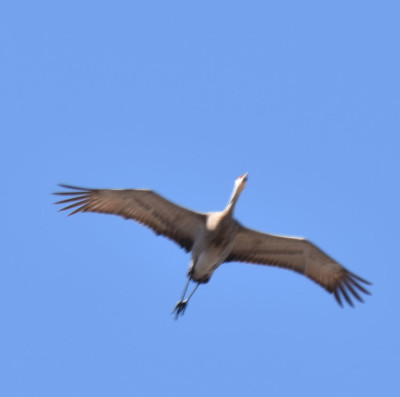
This is another Sandhill Crane, who wasn’t anywhere near as fuzzy as this photo, flying overhead. Unlike a heron, it didn’t fold back its neck.
But it didn’t pay any noticeable attention to the small cluster of photographers staying a respectful distance back at the road edge.
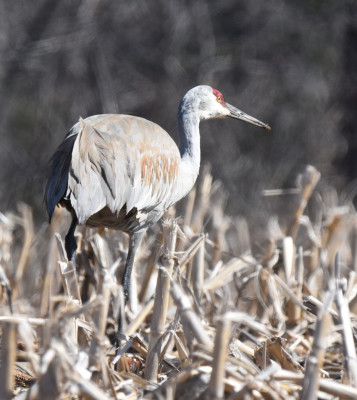
It walked both towards us and away from us based on its own interests.
One of the photographers had been taking photos of Sandhill Cranes at this location for several years and was convinced that this particular bird was the same bird that he had seen and documented here before. He said that was why it genuinely didn’t care about the photographers, which is certainly possible.
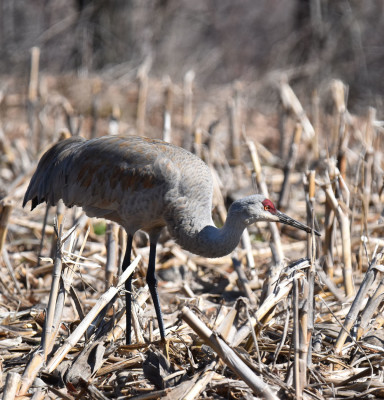
It would listen if other cranes nearby started to call. Can it tell its mate’s voice from other voices?
Why Was I taking Photos of the Sandhill Crane?
As I had made a special trip to look for the Sandhill Cranes, I didn’t need a photo to remind me of how many Cranes I saw. Nor did I have any doubt as to their id. But I still took over 400 photos, most of them blurred. Why?
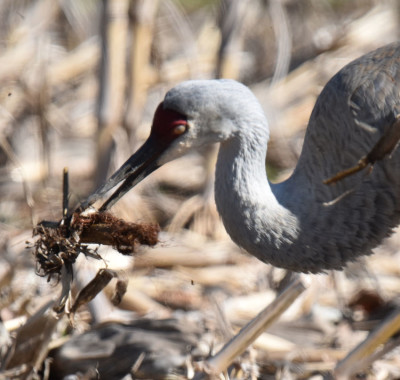
Sometimes it would pick up large clumps of vegetation and shake them, perhaps trying to check for insects or invertebrates or perhaps just because it was annoyed by it.
When I was taking photos of the Crane, I kept trying to use my camera to get more information about the bird and its life.
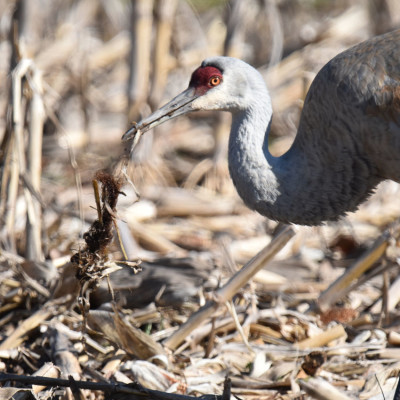
The crane shook this out thoroughly before dropping it.
I tried to get a photo of its foot, which was difficult to do as it almost always stood with both feet firmly planted amidst the thick cover of dead corn stalks. It’s fairly easy to read and find out if they have any toe webbing or long or short claws but it’s more interesting to look for myself.
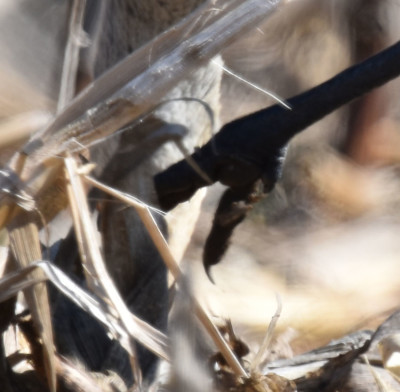
Eventually, I was able to get a look at its claws.
I tried to get a good look at the red heart shape on its head, the texture of its legs, and the bustle of feathers at its nether end.
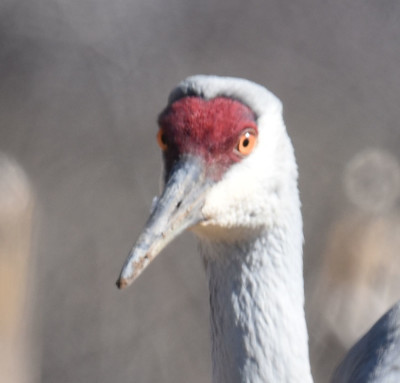
The red is described as skin on AllAboutBirds.
I also was trying to get a deeper understanding of its behaviour. How was the Crane hunting for food in this situation? What was it finding to eat?
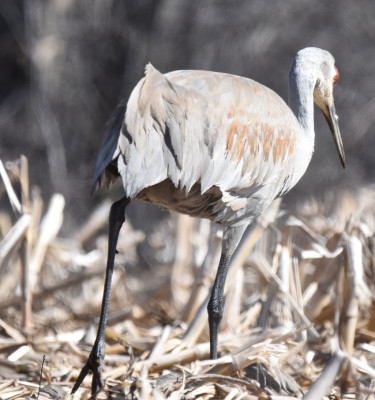
I wonder if the women’s fashion bustle was a result of someone looking at a Crane’s bustle?
None of my photos would impress a photo journalist or a professional nature photographer. But for my purposes many of the shots I took were useful, entertaining and worthwhile.

When I zoomed this on the computer I could clearly see it was an earthworm.
I hope I’ll get another opportunity to take photos of a Sandhill Crane in the future. And I’m sure if I do, I will learn a little bit more about these tall, huge wild “chickens.”
Related Reading
- A Black-Crowned Night Heron at the Rattray Marsh
- A Late Autumn Encounter with Hoodies, Ruddys and a Juvenile Night Heron
- What’s This Large White Wading Bird?
Join In
Do Sandhill Cranes stalk across corn fields or swamps near you? Have you seen them find something interesting to eat? Please share your sighting with a comment.

